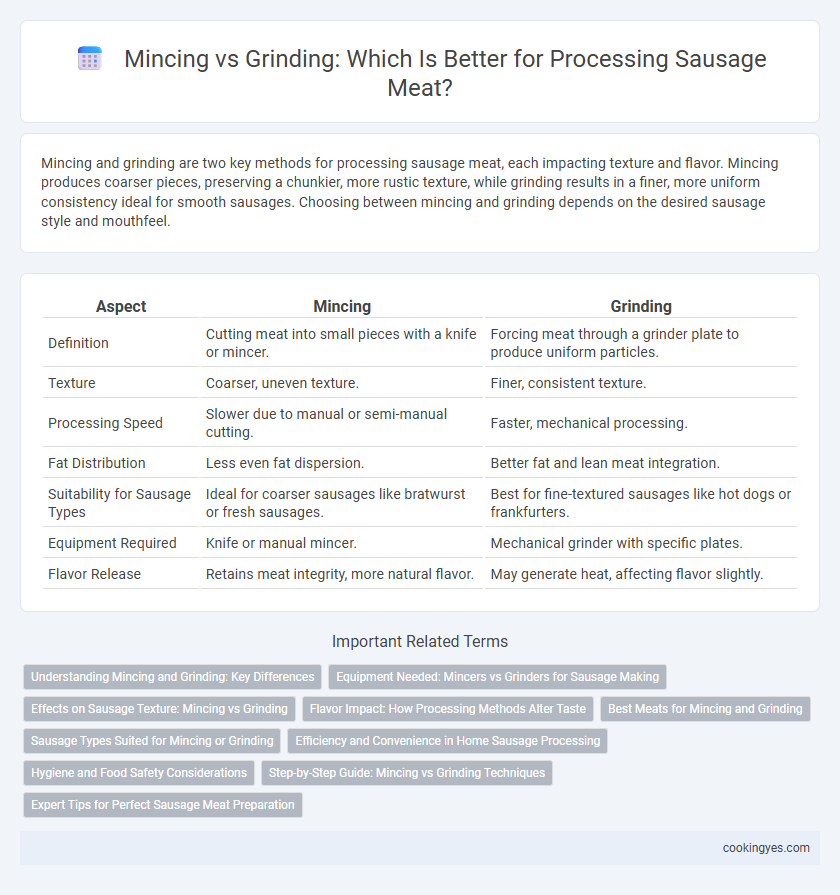Mincing and grinding are two key methods for processing sausage meat, each impacting texture and flavor. Mincing produces coarser pieces, preserving a chunkier, more rustic texture, while grinding results in a finer, more uniform consistency ideal for smooth sausages. Choosing between mincing and grinding depends on the desired sausage style and mouthfeel.
Table of Comparison
| Aspect | Mincing | Grinding |
|---|---|---|
| Definition | Cutting meat into small pieces with a knife or mincer. | Forcing meat through a grinder plate to produce uniform particles. |
| Texture | Coarser, uneven texture. | Finer, consistent texture. |
| Processing Speed | Slower due to manual or semi-manual cutting. | Faster, mechanical processing. |
| Fat Distribution | Less even fat dispersion. | Better fat and lean meat integration. |
| Suitability for Sausage Types | Ideal for coarser sausages like bratwurst or fresh sausages. | Best for fine-textured sausages like hot dogs or frankfurters. |
| Equipment Required | Knife or manual mincer. | Mechanical grinder with specific plates. |
| Flavor Release | Retains meat integrity, more natural flavor. | May generate heat, affecting flavor slightly. |
Understanding Mincing and Grinding: Key Differences
Mincing and grinding are essential techniques in sausage meat processing, each affecting texture and flavor differently. Mincing involves cutting meat into small, uniform pieces to retain a coarse texture, while grinding crushes the meat fibers into finer particles for a smoother consistency. Choosing between mincing and grinding influences sausage quality, moisture retention, and aroma development during cooking.
Equipment Needed: Mincers vs Grinders for Sausage Making
Mincing and grinding require distinct equipment tailored to sausage making, with mincers typically featuring manual or electric models that push meat through perforated plates, creating coarse textures ideal for rustic sausages. Grinders, often more robust and motorized, use rotating blades to finely process meat, ensuring uniform particle size crucial for smooth-textured sausages like bologna. Choosing between mincers and grinders depends on the desired sausage texture, production scale, and precision in meat particle size consistency.
Effects on Sausage Texture: Mincing vs Grinding
Mincing sausage meat produces a coarser texture with more distinct meat fibers, enhancing bite and chewiness, while grinding results in a finer, more uniform consistency that yields a smooth and cohesive sausage. The choice between mincing and grinding affects moisture retention and fat distribution, with grinding promoting better emulsification and juiciness. Texture preferences in sausage depend on the intended culinary use, with mincing favored for rustic, chunky sausages and grinding preferred for delicate, finely-textured varieties.
Flavor Impact: How Processing Methods Alter Taste
Mincing sausage meat creates a coarse texture that preserves larger fat particles, enhancing juiciness and rich flavor development during cooking. Grinding produces a finer, more uniform consistency that allows spices to blend thoroughly, intensifying the overall taste profile. These processing methods directly influence mouthfeel and flavor release, shaping the character of the final sausage product.
Best Meats for Mincing and Grinding
Choosing the best meats for mincing or grinding sausage involves selecting cuts with the right balance of lean and fat content, such as pork shoulder, beef chuck, and lamb leg, which provide optimal flavor and texture. Mincing is ideal for leaner, tender meats like pork loin or turkey breast to maintain moisture and mouthfeel, while grinding suits fattier cuts for a juicier sausage. Proper meat selection ensures consistency in grind size, enhancing the sausage's binding and overall taste profile.
Sausage Types Suited for Mincing or Grinding
Mincing is ideal for sausages like fresh breakfast links and herb-infused sausages where a coarser texture retains meat integrity and enhances flavor absorption. Grinding suits emulsified sausages such as hot dogs or bologna, producing a smoother, uniform texture essential for fine, consistent binding. Selecting between mincing and grinding depends on the desired sausage type, texture, and the balance of fat-to-lean meat for optimal processing.
Efficiency and Convenience in Home Sausage Processing
Mincing sausage meat offers greater efficiency and convenience for home processing due to its simpler setup and faster preparation time, requiring only a basic meat grinder attachment. Grinding, while producing finer texture, often demands more powerful equipment and time-consuming assembly, making it less practical for casual home sausage makers. Choosing mincing allows for quicker batch preparation with less cleanup, optimizing home sausage production workflows.
Hygiene and Food Safety Considerations
Mincing sausage meat involves smaller, uniform pieces that reduce bacterial load by allowing even seasoning distribution and thorough cooking, whereas grinding can create a denser texture that may trap contaminants if not handled properly. Maintaining strict hygiene protocols during mincing and grinding, including regular equipment sanitation and temperature control, is critical to prevent cross-contamination and ensure food safety. Proper mincing reduces microbial risks by enhancing surface exposure, facilitating quicker pathogen elimination during cooking compared to coarser grinding methods.
Step-by-Step Guide: Mincing vs Grinding Techniques
Mincing sausage meat involves finely chopping the meat using a knife or specialized mincer, resulting in a coarse texture that retains more bite and meat integrity. Grinding, on the other hand, pushes the meat through a grinder plate with varying hole sizes, producing a finer, more uniform consistency essential for smooth sausage filling. Choosing the correct technique depends on the desired sausage texture, with mincing preferred for chunky sausages and grinding ideal for emulsified varieties like liverwurst or bologna.
Expert Tips for Perfect Sausage Meat Preparation
Mincing sausage meat with a coarse blade preserves texture and ensures even seasoning distribution, creating a juicy bite. Grinding through a fine plate results in a smoother consistency, ideal for delicate sausages requiring uniform density. Experts recommend chilling the meat and equipment to prevent fat smearing and maintain optimal binding during both mincing and grinding processes.
Mincing vs grinding for processing sausage meat Infographic

 cookingyes.com
cookingyes.com